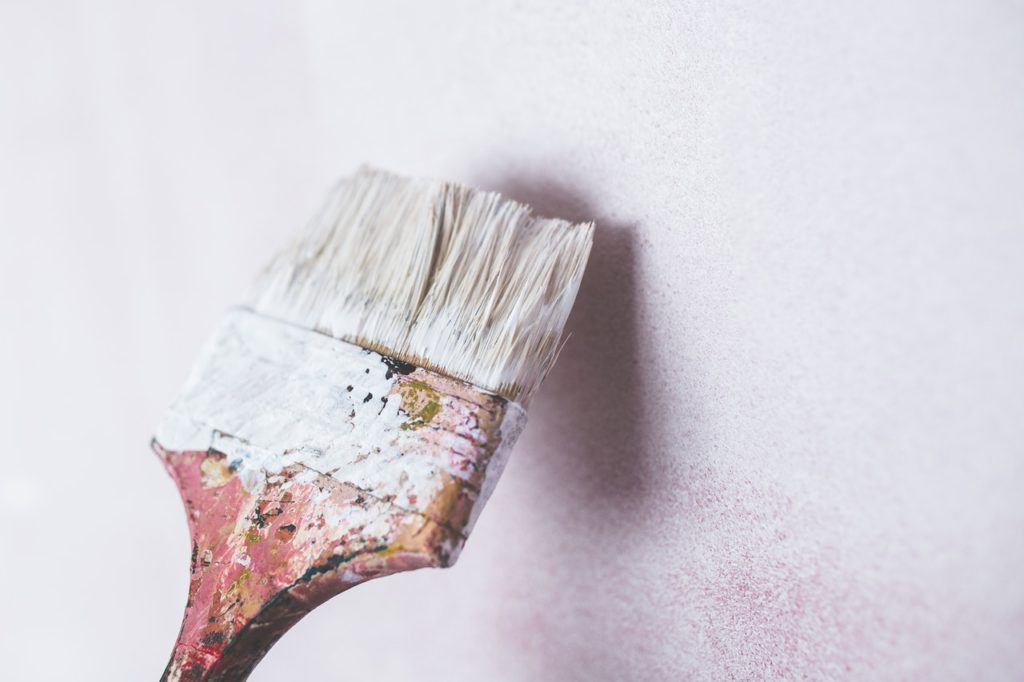Note: Some imperfections in wall and paint surfaces can be expected. Per Castle Building & Remodeling, Inc. contract the Residential Construction Performance Guidelines as published by the National Association of Home Builders will be used to determine acceptable workmanship. The guidelines state “A nail pop, blister, or other blemish that are readily visible from a distance of 6 feet under normal lighting conditions are considered excessive.

Choosing Your Paint Finish
Even after a homeowner has chosen the perfect color for a room, there’s another very important decision to make. With 5 or 6 paint finishes to choose from, you should learn the benefits of each and determine the right one for your job. Should you use flat or satin and why? Browse these tips on selecting the perfect paint finishes for your interior home applications.
Matte Finish
Whether called flat finish or wall paint, this type of interior paint has a matte surface. This paint finish is usually used on interior walls. It’s especially good if you have to camouflage small wall bumps, cracks, or other imperfections, as this finish does not reflect light. While some flat paints are advertised as washable today, you may need to touch up scratches or marks by covering with a bit more paint, so be sure you keep some on hand after you’ve finished painting.
Flat Enamel
Flat enamel is a paint with a durable flat, matte finish. It’s a good choice for powder rooms and halls, as it holds up to occasional cleaning.
Eggshell Finish
If you can picture the very low sheen of the shell of an egg, you have an idea of how an eggshell paint finish will appear. With only a slight hint of shine or gloss, it’s good for walls and holds up better with cleaning than a flat finish paint.
Satin Finish
Satin finish paint has a smooth, velvety look with a bit more gloss. It is most often used for windows, doors, trim, or ceilings, but can also be used as wall paint. This is particularly suitable for kids’ room walls, kitchens, or bathrooms, or in areas which get a lot of traffic. Paint with a satin finish is formulated to hold up to cleaning and light scrubbing.
Semi-Gloss
Semi-gloss paint is most often used on doors, trim, and cabinets in kitchens and bathrooms. It is easily cleaned and lays down a nice, subtle shine, without being too glitzy. Take care with pre-paint preparation work, as poorly prepared surfaces can be a bit distracting when highlighted by a semi-gloss surface.
Gloss
High gloss paints have an almost reflective quality, as their shiny finish mimics the look of enamel or plastic. Tough not widely used in home interiors, it is becoming more popular for a dramatic look on cabinets, trim, and furniture in very formal and very contemporary settings. This finish will magnify any surface imperfections, so careful preparation and sanding is essential before painting with high gloss paints.
Check out Protect Painters website here to compare the pros & cons of different paint finishes.
*Additional resources: Check out this neat website with photos for end products of each type of paint finishes.
Cleanability and Durability
While most manufacturers have developed all paint finishes with good cleaning qualities, a general rule is that the shinier the paint finish, the better it will stand up to washing and cleaning.
While most manufacturers have developed all paint finishes with good cleaning qualities, a general rule is that the shinier the paint finish, the better it will stand up to washing and cleaning.
Kid-Friendly Finishes
When painting children’s rooms, many painters recommend using an eggshell or satin paint on the walls and semi-gloss for doors and moldings. These finishes are formulated to better withstand repeated cleanings.
Rustic Looks
In order to give a worn or old look, use flat finish paints for walls or furniture. If cleanability is an issue, you might select a flat enamel for trim or an eggshell finish for walls.
High Gloss Looks
Rather than choosing a high gloss paint for a whole room, use it sparingly in select locations, such as doors and trim. The brilliant surface can appear a bit cold and uninviting. Remember to spend extra time preparing the surfaces to be painted glossy, as this finish tends to really point out any surface imperfections.
Ceiling Paint
If you’re looking for a basic white ceiling, you can buy pre-mixed, matte finish paints off the shelf at almost any paint or home improvement store. Because cleanabiltiy or coverage is not a particularly important consideration, some ceiling paints use cheaper formulations. If you need an exact color match for the color scheme of your room, choose regular tinted flat wall paint.
Ceiling Finishes
Ceilings in most rooms are painted with a flat finish paint. You could also select an eggshell finish if the surface of the ceiling is flawless. Choose a glossier finish for good light reflection, but only if the ceiling is newly resurfaced and has no blemishes.
Kitchens and Baths
Any room, such as a kitchen or bathroom, that will be exposed to water, splashing, or steam, is best painted with a semi-gloss paint. A guest bath or powder room which will have less-frequent use, could be painted with lower-gloss paint, such as satin or eggshell finish.
Homeowner Done Painting
Many homeowners choose to paint themselves to help save project costs. We have put together some tips to help you understand the responsibilities of acting as the painter on a remodeling project.
The first step is to schedule the painting. Your job as the painter is to work with the Lead Carpenter to schedule the painting. Traditionally painting can occur at two different stages of the project. Painting can happen immediately after sheetrock which eliminates considerable prep, taping, etc. but can lead to nicks, dings, and scratches while the rest of the work goes on. To be safe plan on touching up walls if painting is done early in the project. Painting can also wait until after the rest of the project is complete. This requires more prep and masking but reduces the chance of work related damage.
Part of scheduling the project may be coordinating the delivery of trim and casing in advance of install so you can paint before it is needed by the carpenter.
As the painter it is your job to prepare the space as needed to protect adjacent surfaces and areas. This includes masking windows, taping trim, taping ceilings, using drop cloths, and putting up poly curtain walls if needed or not included in the Castle line-item estimate. Another part of preparing the space is to wipe down the walls and clean the surface to be painted.
After prepping the area to paint there is usually some caulking and spackling of drywall imperfections. Trim and casing also require some touch up to hide nail holes and close gaps at the wall.
Learn more about Fading, Yellowing, Peeling, Cracking, Sagging, Wrinkling Paint Problem – What to do? here>>

